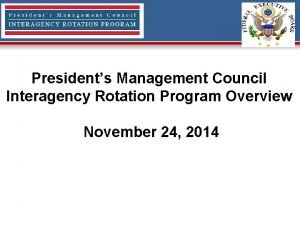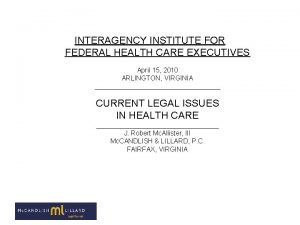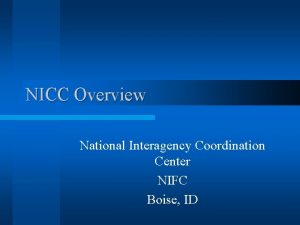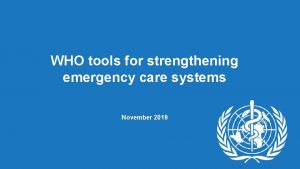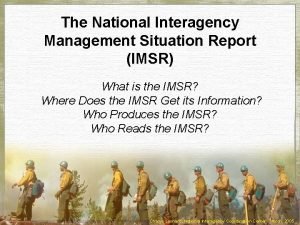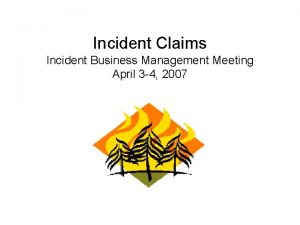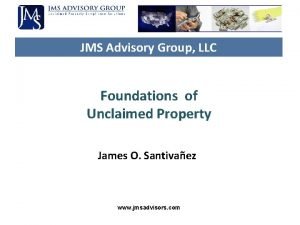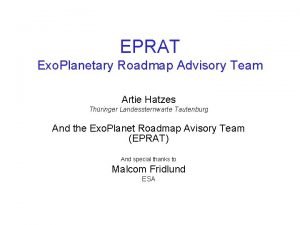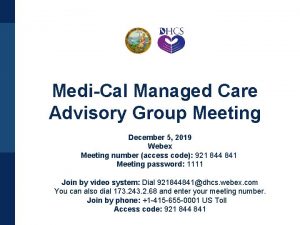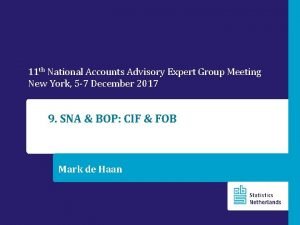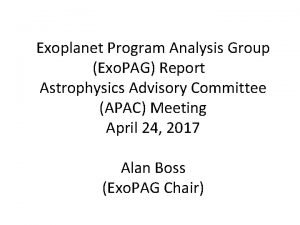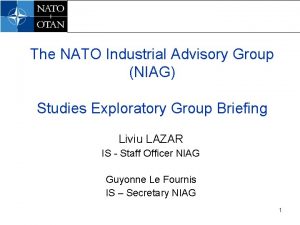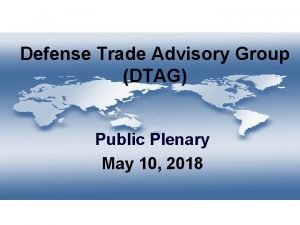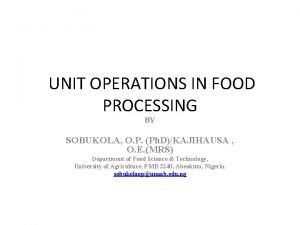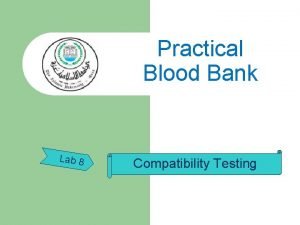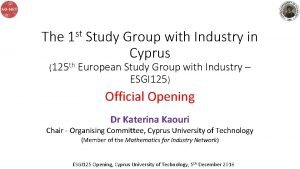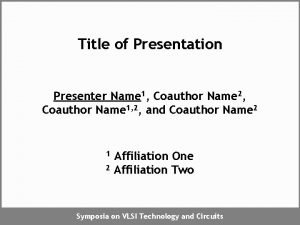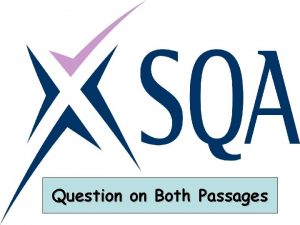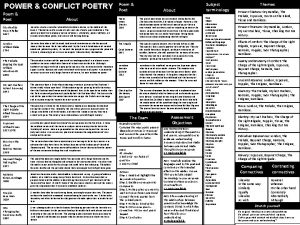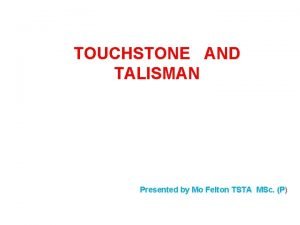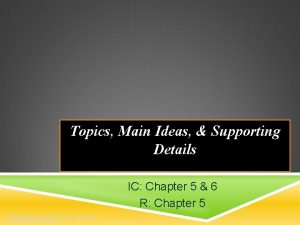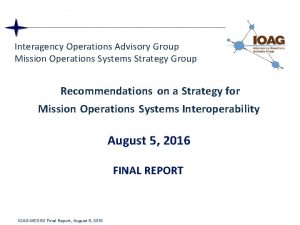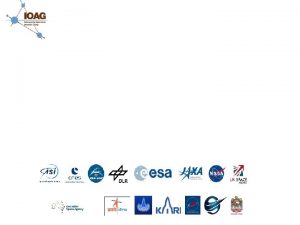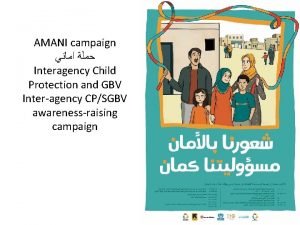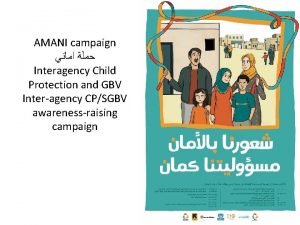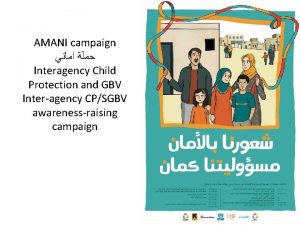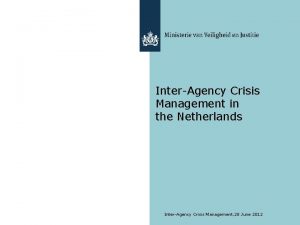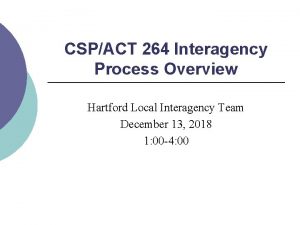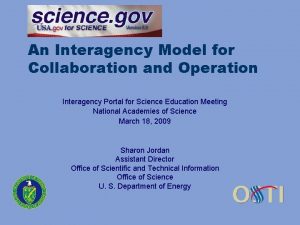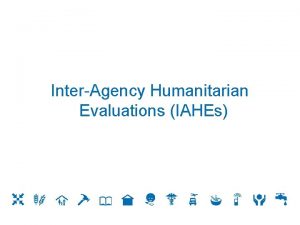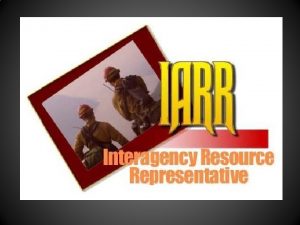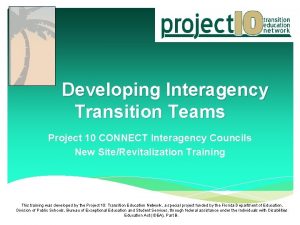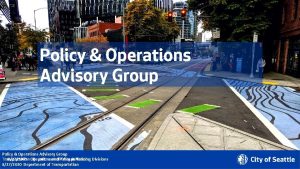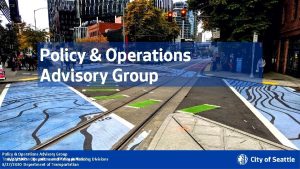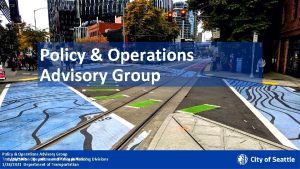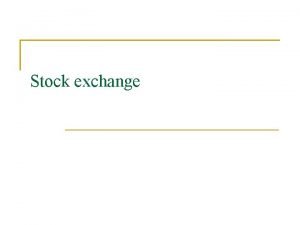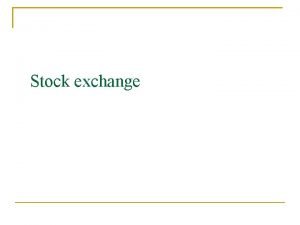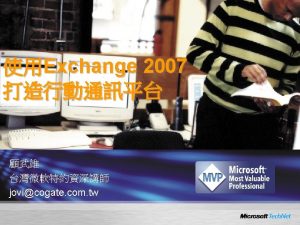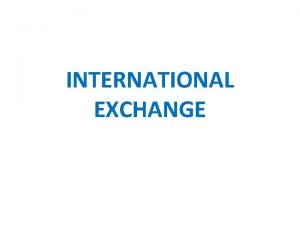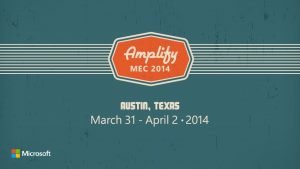Interagency Operations Advisory Group Industry Exchange Workshop Presented






























- Slides: 30

Interagency Operations Advisory Group Industry Exchange Workshop Presented by : IOAG Chair (Michael Schmidt, ESA) on behalf of the IOAG

IOAG Role The IOAG (Interagency Operations Advisory Groups) provides a forum for identifying common needs across multiple international agencies for coordinating space communications policy, high-level procedures, technical interfaces, and other matters related to interoperability and space communications. ü Enable Safe, Secure and Efficient interoperable mission operations ü Enable higher rate throughput for Science, Earth and Exploration missions ü Provide responsive networks around the Earth, Moon, and Mars to enable future Exploration and Science missions The IOAG was founded by the Interoperability Plenary (IOP) to: • understand issues related to interagency interoperability and other space communications matters; • identify common solutions complying with IOP guidance; • recommend resolutions to the IOP for specific actions created by the IOP and put on the IOAG. • 2

Interaction with Commercial Providers and Operators The latest IOP meeting addressed among others the interaction with Commercial Providers and Operators and agreed on the following resolutions: – The IOP acknowledges the potential benefits of a closer interaction with commercial providers and operators of operations services. – The IOP asks the IOAG to explore options and establish mechanisms to engage with relevant commercial providers as an initial step. • 3

IOAG Context Requirements for International Space Mission Interoperability Technology Drivers Space Community Project Needs Frequency Coordination Spectrum Allocation Operations Drivers Navigation Interoperability for Space Operations Standardisation Coordination Ø Service Catalogues Ø Technical Reports Interoperability Framework Coordinated Mission Support Infrastructure • 4

IOAG Organization Chart CMWG, LCAWG, LEO 26 WG, LMWG, MOSSG, OLSG, SCWG, SECSWG, SISG ASI CNES CSA DLR ESA JAXA NASA UKSA Consultative Committee For Space Data Systems (CCSDS) Interoperability Plenary (IOP) Space Frequency Coordination Group (SFCG) CNSA KARI RFSA SANSA UAESA Interagency Operations Advisory Group (IOAG) Interagency Coordination Panel BI / Tri Lateral (ITCOP) Legend: International Programs & Projects BI / Tri Lateral Staffing Function Member Observer International Committee on Global Navigation Satellite Systems (ICG) Working Groups International Space Exploration Coordination Group (ISECG) Liaison Function Requirements Organizations Liaison • 5 Organizations

IOAG Products The IOAG generates / maintains the following products: ü Annual Reports ü Work Plans ü WG Reports ü Service Catalogues ü Communications Assets database ü Mission Models (Earth, Moon, Mars, Others) ü Cross Support Mission Model ü IOAG-CCSDS Product Agreement ü Standards Infusion Status and Plans ü GNSS Receivers Payload database ü Website containing inputs for the various meetings and telecons • 6

IOAG Specific Priority Items (1/3) IOAG has identified top priority items that influence the technical work of the IOAG WGs and the interaction with the various liaisons : ü Protection of critical frequency bands for space research and Earth-exploration satellites (in particular 26, 32 and 37 GHz for WRC-19, as well as 2 and 8 GHz) Ongoing, Close coordination with SFCG Goal Agree on coordinated measures to ensure availability of relevant frequency bands ü Enable High data rates Communications Ongoing, Assessment of Optical Communications (e. g. Benefits and Challenges) and of other frequency bands such as Ka-Band Goal Implement assets allowing interoperability for missions requiring forward and return high data rates ü Promote utilisation of 26 GHz band for LEO missions Ongoing, Assessment of challenges and advantages, follow-up of experiments and technologies Goal Foster the utilisation of 26 GHz that enable cross-support for LEO and other near Earth missions • 7

IOAG Specific Priority Items (2/3) ü Definition of critical IOAG Services relevant to cross-support / interoperability Ongoing, Production and maintenance of IOAG Service Catalogues; Production of infusion tables that reflect the plans of the Member Agencies and industry Goal Implement services that enable interoperability ü Facilitate S/C Emergency Cross-Support Ongoing, Definition of Standard Operations Procedures and validation through experiments Goal Establish a framework that enables emergency cross-support with space agencies and commercial service providers ü Facilitate Navigation Interoperability for Space Operations Ongoing, maintenance of database with GNSS Payloads Goal Ensure that Global Navigation Satellite Systems (GNSS) such as US GPS, European Galileo, Russian GLONASS, Chinese Bei. Dou, Japanese QZSS, and India’s NAVIC are fully interoperable to support space operations and science missions • 8

IOAG Specific Priority Items (3/3) ü Support to future Exploration Program (at this time mainly Lunar missions) Ongoing, definition of a reference communications architecture incl. selection of subset of SFCG recommended frequency bands, identification of appropriate operability standards Goal Develop and implement a responsive interoperable Lunar Communications and Navigation Architecture for implementation by agencies and industry to ensure efficient utilisation of communication resources that enable cross-support and avoid duplication of effort ü Facilitate Space Internetworking Ongoing, define concepts and assess technologies and protocols, in particular DTN, standardisation mostly completed Goal Promote Space Internetworking standardisation (including evaluation and demonstration of DTN) and implement corresponding assets to facilitate operations of complex space systems ü Preparation of Mission Operations Interoperability Services Ongoing, assessment of benefits, definition of a Mission Operations Service Catalogue Goal Foster the utilisation of Missions Operations Interoperability Services / Interfaces to facilitate interoperable operations of complex space systems • 9

IOAG Relations with International Bodies • CCSDS (Consultative Committee for Space Data Systems) IOAG provides guidance, operations drivers and requirements to CCSDS regarding the development of required standards. • ICG (International Committee on Global Navigation Satellite Systems) Exchange of information and IOAG supports the coordination of activities. • ISECG (International Space Exploration Coordination Group) IOAG provides guidance and support regarding the definition and implementation of the communications infrastructure. • SFCG (Space Frequency Coordination Group) IOAG exchanges information with the SFCG on the need for new spectrum allocations and priorities for defending existing allocations by maintaining mission model data. • 10

Summary of Resolutions of IOP International Bodies • Cooperation with international bodies CCSDS, SFCG, ISECG • Achievements recognised • Role of IOAG as focal point for communication aspects endorsed • Future cooperation between international bodies recommended • 11

Summary of Resolutions of IOP Working Groups • Spacecraft Emergency Cross Support Working Group (SECSWG) Achievements recognised, implementation of emergency cross-support encouraged • Low Earth Orbit 26 GHz Study Group (LEO 26 SG) Efficient use of 26 GHz band encouraged • Optical Links Study Group (OLSG) Progress regarding optical communications recognized, collaboration on technology developments and demonstrations recommended • Mission Operations Systems Strategy Group (MOSSG) Interest in in future joint missions with a high degree of interoperability, demonstrate Mission Operations Interoperability services in demo missions • Space Internetworking Study Group (SISG) Value of DTN recognised, Lunar and planetary relay spacecraft intended for cross support be equipped with DTN nodes • 12

Scope of Interaction IOAG Task ü Define and establish a communications architecture to be used among others for the future Exploration Program composed of institutional and commercial facilities Aspects to be addressed: Ø Identify scheme of interaction between IOAG and Commercial Providers / Operators Ø Identify technical evolution in the next decade Ø Identify options for the harmonization of the development of the facilities Keyword: Common Roadmaps Ø Identify opportunities and challenges Let’s have an open exchange • 13

B/U Slides • 14

IOAG WGs Active WGs Ø Service Catalogue Working Group (SCWG) • Describe the core and extended cross-support services that can be provided by the communication assets operated by the IOAG member agencies • Determine a catalog #1 for services available for interaction between a spacecraft control center and a spacecraft directly reachable via a ground tracking asset • Determine a catalog #2 for services available for in-space relay and networked cross support scenarios • Collect the infusion plans and the implementation priorities of the IOAG member agencies with respect to the services and technologies identified in the service catalogs. • 15

IOAG WGs Active WGs Ø Spacecraft Emergency Cross Support Working Group (SECSWG) • Develop a set of Standard Operating Processes / Procedures (SOPs) for providing emergency cross support services, agreed upon by all member of the working group. • Verify the agreed upon principles through the demonstration of the emergency cross support services, following the established SOPs, for selected cases. Mission Operations Systems Strategy Group (MOSSG) • Foster the development and utilisation of standards to facilitate the information exchange necessary between agencies for interoperable space systems operations • Develop a Service Catalog #3 for service-based and format-based interactions between cooperating mission operations ground systems of multiple agencies • Make recommendations to the IOAG regarding strategies to promote and demonstrate the approaches identified in Service Catalog #3 • 16

IOAG WGs Dormant WGs Ø Coding & Modulation WG (CMWG) • Provide agencies with the list of “CCSDS preferred standards” for coding and modulation • Allow agencies to reduce implementation costs for cross support by concentrating on a subset of higher-performing standards • Provide guidance to new missions in choosing among the existing CCSDS standards those with higher support by international community • 17

IOAG WGs Dormant WGs Ø Space Internetworking Strategy Group (SISG) • Provides a recommended approach for transitioning the participating agencies towards a future “network centric” era of space mission operations. • Guides in the development of standards and demonstrations, particularly regarding Delay/Disruption Tolerant Networking (DTN). Ø Lunar Communications Architecture Working Group (LCAWG) • Identification of an appropriate set of frequencies among SFCG list to be used for Lunar missions • Provision of a recommended end-to-end communications architecture relevant to all crewed and robotic Lunar missions • 18

IOAG WGs Dormant WGs Ø Low Earth Orbit 26 GHZ Working Group (LEO 26 WG) • Facilitate the utilization of 26 GHz K-Band (i. e. 25. 5 -27. 0 GHz) direct space-to-Earth data downlink for future LEO missions, in the context of cross supports • Develop high level Concepts of Operations and preliminary Architecture inputs for a 26 GHz K-Band system for low Earth orbit • Determine the business case for cross support at 26 GHz for low Earth orbit applications Ø Optical Link Strategy Group (OLSG) • Provides recommendations to the IOAG with regards to optical space communications architectures, needs for standardization of the CCSDS Optical Communications Working Group, and associated inter-agency interoperability for future missions • Is chartered to work optical communications issues with peer organizations to the IOAG, such as the International Civil Aviation Organization (ICAO) in the area of eyesafety and optical communications impact on aviation, and human spaceflight • 19

Question Catalogue (1/3) • General Questions – (1) What are your expectations when attending this Exchange Day? – (2) Which outcomes would you like to see after this Exchange Day? – (3) Do you have any specific topic that you would like to be addressed in Exchange Day? • Schemes of cooperation between IOAG and Industry – (4) How would Industry envisage benefitting from a relationship with the IOAG? – (5) How could the cooperation between IOAG and Industry been organised? – (6) What should be the goals of a cooperation between IOAG and Industry (e. g. interoperable communications and navigation architecture)? • 20

Question Catalogue (2/3) • Technical evolution in the next 5 to 10 years – (7) What is the foreseen mid-term evolution of your Communication services in the next 5 -10 years? – (8) What are the technology trends that could affect the communications services in the coming years and could or should influence the role and tasks of the IOAG (e. g. Artificial Intelligence and Optical Communications)? • Harmonisation (incl. standardisation) needs for the future � common roadmaps – (9) What are your main concerns regarding the interface between agencies and service providers? – (10) Is there a need for harmonised interfaces (common approaches) regarding service delivery and service management? – (11) What public-private alliance model could be envisaged to ensure a common evolution of the communications infrastructure? • 21

Question Catalogue (3/3) • Opportunities & Challenges – (12) What technical, standardization, and legislative issues stand in the way of having satellites "roaming" capabilities with respect to ground segments, just like it seamlessly occurs with mobile phones? – (13) What are the challenges in coping with the evolution of the set of communications providers and consumers and how do you intend to deal with them? – (14) What are the technical and organisational challenges for which agency support could be beneficial? – (15) In areas where stations of the same commercial provider are co-located, how do the tracking service providers ensure no interferences between the different missions supported by these stations? • 22

APPENDIX • 23

Spacecraft Emergency Cross Support Service Overview • The IOAG established the Spacecraft Emergency Cross Support Working Group (SECSWG) in 2014 in response to an IOP-3 recommendation • Spacecraft Emergency Cross Support (SECS) services are: – Inter-agency cross support services provided during a spacecraft emergency – Minimal-to-zero emergency support coordination between the user mission and the service provider conducted prior to emergency – Include basic engineering and standard TT&C services, when possible, on a best effort basis • SECSWG Goals: – Establish a process and guidelines to make emergency support a permanent cross-support capability between space agencies. – Implement and maintain SECS services with minimal investment from the participating agencies • Participating Agencies: ASI, CNES, DLR, ESA, JAXA, KARI, NASA • 17 September 2019 • 24

“Emergency” Definition • Spacecraft emergency mode is the anomalous state of the spacecraft in which its persistence will result in the loss of the spacecraft entirely or the loss of any of the spacecraft’s essential faculties (payload excluded). • For human space flight missions, any external or internal conditions that could negatively affect the health and safety of the crewmembers are causes for spacecraft emergency mode. • Any ground station failure by itself is not a direct cause for declaring the spacecraft in emergency mode. • SECS is only related to establishing a Telemetry, Tracking and Command (TT&C) link to the spacecraft for recovery operations as well as engineering services. It does not apply to science or mission data acquisition. • 17 September 2019 • 25

Services Available for Emergency Cross Support q q Engineering Services Provided as ‘a best effort approach’ to determine the status of the spacecraft and/or to recover from the anomaly condition Services include: • • • Spacecraft Search Service Downlink signal analysis service Uplink Adjustment Service • 17 September 2019 q q IOAG Standard TT&C Services These core services, as listed in the IOAG Service Catalog, can be provided during an emergency if the missions meets the preconditions specified in the IOAG SECS SOP Services include: • • • Forward Data Delivery Services Return Data Delivery Services Radiometric Services • 26

SECS Standard Operating Processes and Procedures (SOP) • Describes recommended actions for service providers and missions that simplifies the real-time coordination process and reduces the response time during an emergency – Ex. Early coordination on procedures and Points of Contact (POC), RF licensing, creating configuration files at the station, maintaining current trajectory files • Describes services available and frequently used during emergency cross support • Lists Service Provider POCs and available ground stations; provides a template for exchanging spacecraft specification data • SECS SOP draft is currently under review by the IOAG • 17 September 2019 • 27

Implementations Options Support Scenarios As Described in Standard Operating Procedure COMMITTED The provider agrees to: 1. Maintain RF licenses for nominated Spacecraft 2. Maintain a functioning TT&C configuration on the desired ground station 3. Maintain a functioning Comms infrastructure between the agencies involved 4. Maintain a functioning FD infrastructure for processing Orbital Predicts and Radiometric Data 5. Perform periodic validation tracks (6 -12 monthly) on nominated Spacecraft Higher Level of Preparation • 17 September 2019 ACKNOWLEDGED The provider agrees to: 1. Maintain a TT&C configuration on the desired ground station (untested, no periodic validation) 2. Maintain a functioning FD infrastructure for processing Orbital Predicts and Radiometric Data NON-REGISTERED The provider agrees, on a best effort basis, to: 1. Real Time preparation of Ground Station Configuration Notes: In each of the three cases the services provided will depend on the emergency situation. At a minimum, ‘engineering services’ may be available. If the emergency state permits, also full TM/TC and radiometric services. Also, terms of support scenarios may vary between service providers. Low Level of Mission-Service Provider Pre-Coordination Increased Response Time • 28

Potential Opportunities for Industry • IOAG believes that these services present an industry engagement opportunity. – The basic concepts documented in the SOP can be leveraged by industry to serve as candidate emergency cross support providers. • Potential Benefits – Requires minimal industry investment, presenting a possible business case – Creates a standardized process capability between agencies as well as industry • Reduces confusion during an emergency • Simplifies the interface to other agencies • Identifies appropriate points of contact – Creates a centralized location listing available ground stations and points of contact • 17 September 2019 • 29

Implementations Options Support Scenarios As Described in Standard Operating Procedure Service Provider Preparation Prior to Emergency Committed Concurrence of Agency Service Provider to provide best-effort SECS to Mission Ground Station Configuration for User TT&C Periodic Validation & Testing for Ground Station Configuration (6 -12 months) Maintain functioning FD infrastructure for processing orbital predicts and radiometric data Maintain function communications infrastructure Obtain RF Licenses Response Time for Engineering Services Response Time for Return Data Delivery Response Time for Forward Data Delivery Acknowledged Non-Registered Yes Yes No No Yes Yes As Agreed ASAP No No Up to x day(s); not guaranteed Up to x week(s); not guaranteed N/A IPOC then OPOC Agency-Specific Up to x day(s); not guaranteed Up to x day(s); ASAP not guaranteed IPOC OPOC Agency-Specific ASAP Point of Contact Prior to Emergency Point of Contact During Emergency Associated Costs to Mission for Services • Note: Initial Point of Contact (IPOC) information will be provided in the SOP. The Operational Point of Contact (OPOC) information is provided to the user by the IPOC. • 17 September 2019 • 30
 President's management council interagency rotation program
President's management council interagency rotation program Interagency institute for federal health care executives
Interagency institute for federal health care executives National interagency coordination center
National interagency coordination center Interagency integrated triage tool
Interagency integrated triage tool Nicc imsr
Nicc imsr Interagency incident business management handbook
Interagency incident business management handbook Jms advisory
Jms advisory Artie hatzes
Artie hatzes Nathan nau dhcs
Nathan nau dhcs Advisory expert group on national accounts
Advisory expert group on national accounts Exo advisory group
Exo advisory group Nato industrial advisory group
Nato industrial advisory group Defense trade advisory group
Defense trade advisory group Addison currency exchange
Addison currency exchange Pearl exchange activity
Pearl exchange activity Gas exchange key events in gas exchange
Gas exchange key events in gas exchange Unit operations in food industry
Unit operations in food industry Btec level 3 extended diploma in performing arts
Btec level 3 extended diploma in performing arts Exchange transfusion blood group selection
Exchange transfusion blood group selection European study group with industry
European study group with industry Kicker headlines
Kicker headlines Name/title of presenter
Name/title of presenter Strange case of dr jekyll and mr hyde setting
Strange case of dr jekyll and mr hyde setting Love themes in romeo and juliet
Love themes in romeo and juliet Identify a key term used in both passages
Identify a key term used in both passages Presenter title
Presenter title How is power presented in ozymandias
How is power presented in ozymandias Cognitive learning theory by jerome bruner
Cognitive learning theory by jerome bruner How is hyde presented as a frightening outsider
How is hyde presented as a frightening outsider Talisman presented
Talisman presented Topic, main idea and supporting details examples
Topic, main idea and supporting details examples
